PRINCETON, NJ -- Even as the S&P 500 Index remains at its highest level since October, Gallup's key economic measures don't find Main Street keeping up. During the week ending Aug. 23, consumer confidence fell, self-reported average daily spending gave up what it gained during the prior week, and job creation was unchanged. Whatever is driving Wall Street doesn't seem to be inspiring American consumers, nor is it increasing jobs or spending, as both remain well behind their year-ago levels.
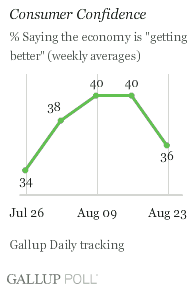
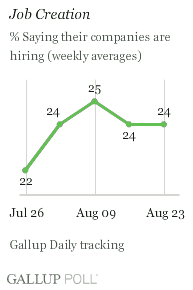
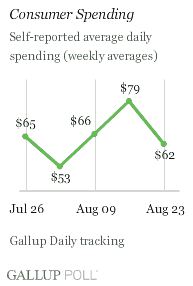
What Happened (Week Ending Aug. 23)
-
Consumer Confidence declined last week, as the percentage of Americans saying the economy is "getting better" fell to 36% from 40% the prior two weeks. Still, confidence for August so far remains up from 34% a month ago and 16% a year ago. At the same time, on a short-term basis, the percentage saying the economy is "getting worse" increased to 57% from 54% the prior week, but remains slightly better than the 61% of a month ago. Americans' views of the current economy also worsened for the week, with the percentage rating the economy "poor" going up two points to 46%.
-
Consumer Spending gave up its gains of the prior week, as self-reported average daily spending in stores, restaurants, gas stations, and online plunged $17 per day -- more than its $13 gain of the prior week -- and representing a 22% week-over-week drop. Spending is down 33% from its level of a year ago.
-
Job Creation was unchanged last week, with 24% of employees saying their companies were hiring. At the same time, the gap between job creation and job loss closed, as 24% also said their companies were letting people go -- down slightly from the 25% of the prior two weeks and the 26% of a month ago. The percentage of companies reported to be hiring is down 35% from the same week a year ago.
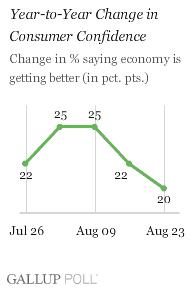
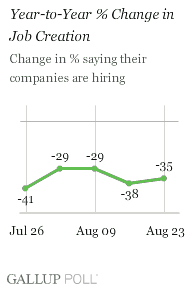

What to Watch For
On Tuesday morning, the Conference Board will report on its consumer confidence index for August. Although Gallup's consumer confidence measures fell during the week ending Aug. 23, weekly confidence data has been considerably higher in August -- reaching their high for the year -- than in July. As a result, the consumer confidence index report will probably show an increase. The same should hold true for the Reuters/University of Michigan August consumer sentiment report Friday -- despite the fact that its preliminary reading showed an August decline. Regardless, both reports may be out of date by the time they are released, given the recent trend in the ���۴�ýdata.
The Labor Department reported last Thursday that jobless claims rose by 15,000 to 576,000 in the week ending Aug. 15, and the four-week moving average of initial claims increased to 570,000. Gallup's Job Creation measure suggests no improvement in job creation, and Gallup's data for the week ending Aug. 23 suggest that jobless claims will exceed the current consensus of 565,000 when reported on Thursday -- surprising once again and reinforcing the idea of job-market weakness.
Most importantly, Gallup's spending data suggest that the surge in consumer spending to a new high for the year during the week ending Aug. 16 may end up being a sizable but brief blip, as opposed to an improvement in the trend. In turn, this suggests a disappointing back-to-school sales period for most retailers.
Right now, the equity markets continue to surge while oil and other commodities do likewise. The resulting increase in consumer prices at the pump and in the grocery store is not likely to produce increased consumer spending that is already being held back by the spending "new normal" and harder-to-get consumer credit. Although it seems unlikely that Wall Street and oil prices can continue to diverge sharply from the Main Street economy for too long, the increased consumer prices created by that divergence can do added damage to today's already-weak consumer spending.
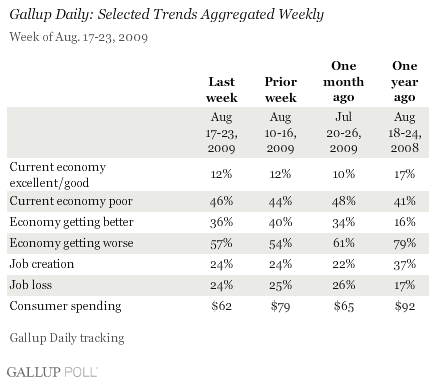
Survey Methods
For ���۴�ýPoll Daily tracking, ���۴�ýinterviews approximately 1,000 national adults, aged 18 and older, each day. The ���۴�ýconsumer perceptions of the economy and consumer spending results are based on random half-samples of approximately 500 national adults, aged 18 and older, each day. The ���۴�ýjob creation and job loss results are based on a random half sample of approximately 250 current full- and part-time employees each day. For the total samples of these surveys, one can say with 95% confidence that the maximum margin of sampling error is ±3 percentage points.
Interviews are conducted with respondents on land-line telephones (for respondents with a land-line telephone) and cellular phones (for respondents who are cell-phone only).
In addition to sampling error, question wording and practical difficulties in conducting surveys can introduce error or bias into the findings of public opinion polls.
